| 0 | ||||||
| 7 | 6 | 5 | 4 | 3 | 2 | 1 |
| 14 | 13 | 12 | 11 | 10 | 9 | 8 |
| 21 | 20 | 19 | 18 | 17 | 16 | 15 |
![]()
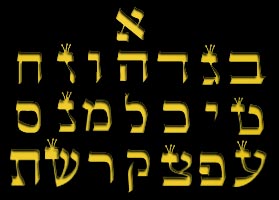
|
In the tableaux above, (not counting 0):
|
GLYPHSSymbols carved in stone, or metal - these are called glyphs.
A glyph contains a complete idea, and communicates the idea to others who are familiar with the glyphic symbol.
A symbol 'stores' psychic energy - we attach whole modes of feeling to the glyphs in society, from the swastika to the peace sign.
A Logo, whether it be a tattoo or a corporate brand, is a glyph. A letter in the alphabet, a numerical sign or punctuation mark, these glyphs all tell us something, and are the basis of our written communication.The "Ets Chaim" - Tree of Life - is itself a glyph. And in a sense, all of infinite creation is a glyph, a fractal, of the mind of "God."
The tables below show several 'alphabetic' systems, all linking to their corresponding Keys in the Tree of Life.
The Cube of Space, another powerful glyph, is at the bottom of this page.
Table of Contents
Tableaux
GlyphSquare
Solstices & Equinoxes
Zodiacal Symmetries
Dignities (Exaltation, Fall)
Planetary Aspects
Lunar Nodes
Saturn Returns
Hemispheric Balances
Houses
Sabbats
Hebrew/Roman Letter Equivalents
Cube of Space [right panel]
To return to the Qabala Home (right window), click
Qabala Home
To see the Qabala Overview page (right window), click
Overview
To return to the Tree (this window), click
TREE
TABLEAUX
| 0 | ||||||
| 7 | 6 | 5 | 4 | 3 | 2 | 1 |
| 14 | 13 | 12 | 11 | 10 | 9 | 8 |
| 21 | 20 | 19 | 18 | 17 | 16 | 15 |
![]()

|
In the tableaux above, (not counting 0):
|
The twelve astrological signs are represented by the 12 upper glyphs in the chart below. Ten planets or bodies are shown below that.The twelve signs are composed of four 'elements:' Earth, Air, Fire and Water. The elements are subject to three conditions: Cardinal, Fixed, and Mutable. In the chart, the elements are grouped horizontally, and the conditions vertically.
The planets are arranged in random order.

The planets are like characters in a play. How they behave is influenced by what sign they are in, what house they are in, and how they are aspecting the other planets. A birthchart shows the particular scenario being enacted at the moment of 'landing on earth,' and the 'personality ingram' stamped on that soul.PLANET: What you want
HOUSE: Where you seek it
SIGN: How you go about it
TREE [This Frame]
Qabala Home [Right Frame]
Overview [Right
Frame]
![]()

Solstices & EquinoxesBecause the Earth is tilted 23° on its axis, we have four seasons. At the Solstices, one hemisphere of the planet is away from the sun, and experiences shorter days and longer nights,Winter, and the other is towards the sun, and has Summer.
At the Equinoxes, days and nights are of equal length in both hemispheres.
(The systems described in this site are for the Northern hemisphere).
![]()
Each person's horoscope/chart is composed of the 10 bodies arranged
into the 12 signs, placed in 'houses' according to time and place of birth.
Each chart is a mixture of all of the permutations, and must be weighed carefully as to its varying ingredients and formations.
The descriptions of the signs here show them in their essences. People are usually a complex mix of several signs - these commentaries describe the strongest archetypal features of each sign, as if it were alone in the zodiac.
For convenience, we refer to a person as being a specific sign according to where the sun was when they were born; but each person is much more than that.
The Zodiac
...is the "magnetic field" of the Earth; the "planetary aura," the auric egg of the planetary being....is the placenta of the embryonic Earth - body. All cosmic relationships in which Earth can ever enter, all outside radiations which can ever penetrate Earth's atmosphere, and thus the lungs and blood of every organism on Earth, must pass through the Zodiac.
Dane Rudhyar, The Astrology of Personality
ZODIACAL SYMMETRIES
The binary nature of creation is reflected in the Zodiac. The signs alternate, between positive and negative, day and night, extroverted and introverted, forward looking or nostalgic, male and female, yang and yin. Fire and Air are Yang (positive), and Earth and Water are Yin (negative).

Earth (sensation), Air (thinking), Fire (intuition), and Water (feeling) fall into "Triplicities" and "Quadruplicities;" Three forms of each of the four elements.
FIRE: Aggression, executive ability, confidence, pride, leadership, courage, insolence.
EARTH: Focus, determination, dedication, devotion, stability, luxury.
WATER: Emotion, flexibility, intuition, responsiveness, nurturing, psychic powers.
AIR: Mobility, mental activity, communication, ideas, language.
![]()
THE THREE CROSSES

The Cardinal Cross
The Cardinal signs, Aries, Cancer, Libra, and Capricorn, have these properties in common: a consciousness of self, a sense of responsible authority over others, an inclination to lead, to further the evolution of others, and a daring nature. These 'angular houses' are concerned with making manifest and concrete, bringing out into the open, unveiling whatever is latent.
The Yang Cardinal signs, Aries and Libra, demonstrate this socially, in the outer world, while the Yin Cardinal signs, Cancer and Capricorn, exert influence within inner circles, or from an authoritative distance.
ACTIVITY. Cardinal signs need channeling, focus, clear goals. They are active, and dynamic, interested in crisis, activity, and what is going on.
Cardinal signs initiate the knowledge of their triplicity.
Squares and oppositions to cardinal signs are faults and unlearned lessons from previous lives.
Alice Bailey calls this the "Cross of the Risen Christ"
![]()

The Fixed Cross
The fixed signs, Taurus, Leo, Scorpio, and Aquarius, have these properties in common: they have "spiritual or material store," or a "reserve" of spiritual force with which to help themselves or others.
The Yang fixed signs, Leo and Aquarius, demonstrate this in the outer world, socially and in public roles while the Yin Fixed signs, Taurus and Scorpio, use their spiritual store with more reserve, and work out of the spotlight.
WILL. Fixed signs need flexibility, balance, relaxation. They are latent and stable, interested in values and ideas.
Fixed signs concentrate the wisdom of their triplicity.
Squares and oppositions to fixed signs are harmful effects from misuse of will. These are the most difficult and most deeply ingrained karmic debts.
Alice Bailey calls this the "Cross of the Crucified Christ"
![]()
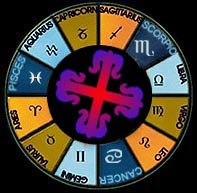
The Mutable Cross
The Mutable signs, Gemini, Virgo, Sagittarius, and Pisces, have these properties in common: a tendency to work, or process, to shuffle, change, juggle and arrange.
The Yang mutable signs, Gemini and Sagittarius, demonstrate this in the outer world, and are blatant, while the Yin mutable signs, Virgo and Pisces, work behind the scenes, or with subtlety.
WISDOM. Mutable signs need focus and perseverence. They are harmonizing and adaptable, interested in people and relationships.
Mutable signs disseminate the wisdom of their triplicity.
Squares and oppositions to mutable signs show new manifestations of karma, and are easiest to process.
Alice Bailey calls this the "Cross of the Hidden Christ"
The person with many planets or emphasis in fixed signs, for example, will respond to life much differently than the person with emphasis in mutable or cardinal signs.
| 7 | 6 | 5 | 4 | 3 | 2 | 1 |
| 14 | 13 | 12 | 11 | 10 | 9 | 8 |
| 21 | 20 | 19 | 18 | 17 | 16 | 15 |
TREE [This Frame]
Qabala Home [Right Frame]
Overview
[Right Frame]
Planetary Dignities
or
"Exaltations, Rulerships, Detriments, and Falls"
These terms are used in astrology to describe how a particular planet's characteristics are "filtered" by the sign they are in when a chart is cast. The expressive power of a planet is affected by its sign and house placement.
The planets "rule" their home signs (some planets have dual rulership).
|
Planet |
Ruler | Detriment | Exaltation | Fall |
| Sun | Leo | Aquarius | Aries | Libra |
| Moon | Cancer | Capricorn | Taurus | Scorpio |
| Mercury | Gemini Virgo |
Sagittarius Pisces |
Aquarius | Leo |
|
Venus |
Taurus Libra |
Scorpio Aries |
Pisces |
Virgo |
|
Mars |
Aries Scorpio |
Libra Taurus |
Capricorn |
Cancer |
|
Jupiter |
Sagittarius Pisces |
Gemini Virgo |
Cancer |
Capricorn |
|
Saturn |
Capricorn Aquarius |
Cancer Leo |
Libra |
Aries |
| Uranus | Aquarius | Leo |
Scorpio |
Taurus |
| Neptune | Pisces | Virgo | Cancer | Capricorn |
| Pluto |
Scorpio |
Taurus | Pisces | Virgo |
The boundary between the inner or "personal" planets, and the outer, "impersonal" planets is Saturn. The inner planets are about refining our responses; the outer planets are things beyond our conscious control.
As always, these interpretations must be viewed in light of other aspects of the chart, such as house placement and planetary configurations. Difficult aspects and unfavorable placements are Karmic hurdles we have assigned ourselves.
Karma, Dharma, and Lunar Nodes
"Lunar Nodes" are points on the ecliptic where the Moon passes from southern to northern latitude.
![]() TREE [This
Frame]
TREE [This
Frame]
Qabala Home [Right Frame]
Overview
[Right Frame]
LIFECYCLES
Saturn returns, Jupiter cycles, transits, and retrograde motion.
Perhaps the most carefully watched planet (other than the moon) is Saturn, which has a 28 year orbit through the 12 signs of the Zodiac. The dreaded "Saturn Return" is just one of many Saturn tests we are put through. When Saturn, in its year to year progress, aspects its position in a person's birthchart, it performs its function: it tests, analyzes, it challenges. For about two years, 28 year olds face themselves and hard reality, usually as never before.
Spending a little over two years in each sign, Saturn tweaks itself against its own position in the natal chart every seven years. (Two squares, an opposition, and a conjunction - the "return.") Thus, the 7 year old's first loss of dreamy childhood innocence, the 14 year old's hormonal hurricane, the 28 year old's full fledged adulthood, and so on. The milestones of 55 and 56 usually mark turning points in people's lives.
Saturn's tests are more difficult when we have been resistant to change, or procrastinated about things that matter.
In its 28 year journey, Saturn also aspects the other points in a natal chart, and it is useful to keep an eye on Saturn vis-a-vis your other natal planets.
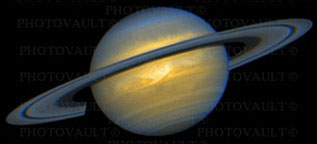
Most people can map changes and stages in their lives just by looking at Saturn's position for a particular time. A long period of testing in your life can often be traced to a Saturn square with your natal Sun, Moon, ascendant, or other planets.
People with strong Saturns are slow to change, so Saturn aspects often mean the difference between "normal" testing and Heavy Testing. Saturn's role as a Zodiacal influence is discussed more in Key 21.
Jupiter's movement through the 12 Zodiacal signs takes a little over 12 years, and has particular influence for people with strong natal Jupiter positions. These people can map changes and stages in their lives just by looking at Jupiter's position for a particular time. Jupiter people are often quite versatile, and can find their enthusiasms switching gears just as Jupiter moves into a new sign, aspects a birthchart position, or completes a return.
Jupiter effects everyone, of course, and "strokes of luck" can often be related to a good Jupiter aspect with a natal formation.
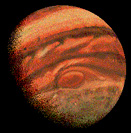
Jupiter's role as a Zodiacal influence is discussed more in Key 10.
"Transits" are what today's planetary positions are, and are often mapped over the birthchart to predict daily situations. This is called "horary" astrology, from the word "hourly." When done with the personal planets (Mercury, Venus, and Mars), it shows daily issues and opportunities; when done with the extrapersonal planets (Jupiter, Saturn, Uranus, Neptune, and Pluto), it shows issues, tests, and opportunities on a yearly, decade, or even larger time scale.
"Retrograde" is a concept that can best be defined with an analogy. Driving on the freeway, at 70 mph, a train next to the freeway that is going 50 miles an hour appears to be going backwards, even though its moving in the same direction. This is retrograde motion. The planets all move the same direction around the sun, but because of their relative positions, sometimes appear to be moving backwards. Astrology says that whan a planet is retrograde, its influence is lessened, weakened or subverted.
"Retrograde" is an example of a "weak planet," as mentioned above. Planets in detriment or fall would be "weak." Examples of debilitating aspects could be, say, a Pluto/Venus conjunction or opposition on the Virgo/Pisces axis, or a retrograde Mars in Cancer conjunct the ascendant, opposing Neptune in the seventh, all squaring a retrograde Saturn in Aries.
"Strong" planets are conjunct cadent cusps (see below), or in their rulerships or exaltations (see above). Examples of empowering aspects could be, say, a Jupiter/Venus conjunction in Capricorn trine the Sun in the first house, or a Jupiter/Sun/Venus stellium in the tenth house trining a first house Mars. The first few degrees of a sign are called the "Cusp," where its archetypal stamp is newest. Planets less than 5 degrees after the cusp of a sign are usually gifted in some way. Planets a few degrees before a cusp are said to be Balsamic, that is, having a premonition of the impending sign change/transformation.
TREE [This Frame]
Qabala Home [Right Frame]
Overview [Right
Frame]
Hemispheric Balances
Ways to look at the hemispheres and primal cusps of the wheel chart, useful for chart analysis. The numbers show the houses. The houses show the circumstances, the environment through which the energies operate, where and when things are done. Planets are influenced by sign, house, hemispheric placement, and other planets.
The Ascendant, Nadir, Descendant, and Midheaven are the cadent cusps (cardinal signs); the points of the material cross. These are also called "Angular" houses or signs. Planets or nodes aspecting these points are emphasized.
The upper, day hemisphere is objectivity, from Libran social skills, through Capricorn's achievements, to Piscean selflessness, or dis-connectedness from self. The upper hemisphere is more controlled by the other, or how the native relates to the other.
- Ascendant: Outer personality, persona, physical appearance, dawn
- Nadir: Inner world, soul, home, base of operations, midnight
- Descendant: The not-self, relationship, marriage, adversaries, sunset
- Midheaven: Prominence, achievement, high noon
The lower, night hemisphere is subjectivity, from the unconscious, instinctual self obsession of Aries, through Leo's unself-conscious self possession while on night's theater stage, to Virgo's willing self-subjugation to other. The lower hemisphere is more under the personal control of the individual.
The rising, or eastern hemisphere of self is sowing, while the setting, western hemisphere of other is reaping.
The chart above is "natural," with Aries ascending, and in the first house, Taurus in the second, and Gemini in the third, etc. A person with Virgo ascending would have Libra in the first, Scorpio in the second house, Sagittarius in the third house, and so on.
"HOUSES" EXPLAINED
The houses "stay locked" to the Earth as it revolves across the Zodiac in the background. The Ascendant (1st) is always dawn; the Descendant (7th) is always sunset. Noon = Midheaven (10th); Midnight = Nadir (4th). As the Earth turns, the constellations of the Zodiac move through the houses. Thus we can have "Leo in the First House," for example, meaning planets in Leo were rising at sunrise. In this example, the "Sun is in Leo," and "Leo is ascending." At this moment, all of the other signs and planets are positioned around us; if Venus were in Libra for example, it would be in the second or third house, below the horizon, due to rise in about 3 or 4 hours.
The houses are like "arenas," or "venues," in which energies (planets) perform. Their characteristics are roughly analogous to the Zodiacal signs; with Aries = 1st, Taurus = 2nd, etc.
The four quadrants of the Zodiac are shown in Roman numerals on the chart above. Below, they are each divided into three, yielding the 12 houses:
Phase I: Survival as a person.
First House The "I" and its immediate needs of identity.
Second House The "I" and its physical, material support.
Third House The "I" and its intellect.
Phase II: Survival in the family; expanding to close "others."
Fourth House The immediacy of the family; the Mother.
Fifth House The materialism of family; speculation, creativity.
Sixth House The intelligence of the family; health, work, service.
Phase III: Relationships to strange "others."
Seventh House The "I" and its identification with other "I's"; thus, marriages, partnerships, interpersonal commitments and involvements.
Eighth House The relationship of the "I" to the materialism of others; finances of others, inheritance, etc.
Ninth House The relationship of the "I" to the intellect of others; spreading of ideas and knowledge; integration of varied modes of thought.
Phase IV: Relationships with groups of others plus self.
Tenth House The "I" and it's relationship to the expectations of others; thus status, profession, social standing, the Father.
Eleventh House The "I" and it's relationship to organized groups of others; community idealism.
Twelfth House The "I" and it's relationship to the work, service, and health of others; the "I" being its own shadow: the "backside" of the First House.
ASPECTS
"Aspects" are what Astrology calls the positional relationships
between the planets. Aspects tell us how the different forces within and without
a person will manifest. Aspects are used in birthchart analysis, in comparing
people's charts (synastry), and also in predicting current or future events
(horary astrology).
Aspects are like the harmonic patterns in nature that we are all familiar with. A rainbow is a good example, the way the colors of the spectrum "sort themselves" into bands. Another example is how a guitar string, if tapped in specific places, will produce two different sounds at the same time that harmonise with each other. For another example try this simple experiment. Take a long cardboard tube, like what they use for wrapping paper, (shorter won't work), and whistle a long, slow, descending note into it. No matter how you try to smooth the note, it will break up into steps, into clearly defined notes in a scale. The same kinds of patterns emerge among the planets. This is what Pythagoras called the "Music of the Spheres."
Aspects show where harmonies or dissonances are apt to emerge.
Aspects, the key points in a chart, are binary, that is, they manifest in ways we interpret as "positive" or "negative." An aspect may evolve or degenerate spiritually, depending on the person's choices, choices influenced by still other aspects in their chart.
Aspects occur between any of the things considered in a Horoscope chart, such as the Planets, the Sun, the Moon, the Ascendant, Descendant, Nadir and Midheaven, the Lunar Nodes, Part of Fortune, and any number of comets, asteroids, stars, and even galaxies. The "Grand" aspects are the most pronounced manifestations, while the fractional aspects show lesser intensities of the same phenomena.
There are two "families" of aspects, triangular, and square. This will cover these kinds of aspects, leaving the Quincunx, Parallels, and Inconjuncts for others to analyse.
When dividing any circle, including the Zodiac, you can do it by cutting it
into halves and quarters, or by cutting it into thirds.
(The idea of aspects based on prime-number polygons is worth exploring...)
Thirds are more difficult to measure, but they are one of Nature's preferred patterns.

The hexagon has the smallest perimeter possible for a given area. The honeycomb shape is hexagonal, because it is the most economical on beeswax. "Hex" is the Greek "six" - six-sided. Bubbles also converge around six-sides, and snowflakes, also, are six-sided. The "Trine" or "triangular aspect" emerges from the Hexagon.
A circle is divided into 360 Degrees - Aspects between planets, bodies, or nodes that divide this number evenly by three fall into the Trine family of aspects.
Trine Family
|
The "opposite" pattern to the Trine is the Square. Trine and Square are opposite in that they are the two elements in a duality. While trines "flow," squares "block" or, "carve." Squares in Nature are the rocks, the edges, the sharp corners, abrupt changes, the bones.

Square Family
|

Squares are often called "Working" aspects, while Trines are called "Beneficent" aspects. Saturn and Mars are associated with Squares, while Jupiter, Venus, and Neptune are associated with Trines.
Oppositions are technically "Square" aspects, but their symmetry places them into another duality: Opposition / Conjunction. The Conjunction is when two or more points occupy the same spot in the Zodiac at the same time.
What The Aspects Do
Trines lend ease, bring opportunity, bestow talent, and intensify other traits. They show Karmic Merit accrued from other lifetimes. Trines can act as Guardian Angels, or "Lucky Stars." They can also lead to laziness, ingratitude, or depending on luck instead of effort.
Squares show character, present obstacles, and intensify other difficulties. They show Karmic Debts accrued from other lifetimes. Squares can show where the danger is. Squares can make a person dependable, and have epic integrity, or can show a person that has a life full of constant problems and difficulties.
Oppositions show awareness, and they can show intractable confrontations, or strong, productive face-to-face relationships. Oppositions give perspective, and a clear vision of a situation, but can also make perspective difficult, as in an optical illusion where two objects appear to be next to each other but are actually at different distances.
Conjunctions show intensity of focus or life force, and can bring clear vision or lack of perspective. Conjunctions of planets with conflicting natures can bring difficulty, and by the same token, harmonious conjunctions can bring ease or fortune.
ORB is the range of degrees in which an aspect is valid. The Sun is allowed a 10 degree variance, while the outer planets are allowed fewer degrees in which they have influence.
Some charts have few major aspects, others have many. People with many strong aspects can find change difficult, or be people of Historic Proportion, whereas people with few major aspects can be quite flexible and well balanced, or seemingly lost in the world. People with few aspects can suffer from a lack of purpose, while people with major aspects can find themselves in deep ruts.
When including the variables of Planet Sign / House placement, the labyrinthine complexity of aspect - possibilities in any chart can be bewildering. Depending on the particular "theme" of the chart, a pattern that brings genius and success for one person may be a disaster for another, because of some slight difference at the "seed" level. [see: Key 3] Look for these "Seed Themes" in the Lunar Nodes and Saturn placement.
TREE [This Frame]
Qabala Home [Right Frame]
Overview [Right
Frame]
SABBATS
The Sabbats are the original Pagan holy days. There are the "Greater" Sabbats, and the "Lesser" Sabbats. The Greater Sabbats, called "Crossquarters," occur at the peak of each season, and the Lesser Sabbats are at the Solstices and Equinoxes. These are all times of community ritual, with Beltane the most fervently celebrated.The crossed "d," which occurs in the Scandinavian languages, looks like: "�" or "�." It is a combination of the "d" and "th" sounds, producing a "dth."
TREE [This Frame]
Qabala Home [Right Frame]
Overview [Right
Frame]
![]()
Hebrew - Roman alphabet equivalences:In the chart above, the left columns show the Hebrew letter, the middle shows an approximate pronounciation, and the right columns show the Roman alphabet equivalent.
The Gematria values for the letters are shown below the pronounciation of the letters. Gematria, Qabalistic Numerology, compares number values for words, and finds connections and similarities. There is another table of letters and gematria values in Key 0.
TREE [This Frame]
Qabala Home [Right Frame]
Overview [Right
Frame]
The Cube of Space
view in right panel

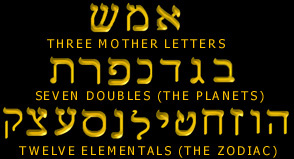
| 7 | 6 | 5 | 4 | 3 | 2 | 1 |
| 14 | 13 | 12 | 11 | 10 | 9 | 8 |
| 21 | 20 | 19 | 18 | 17 | 16 | 15 |